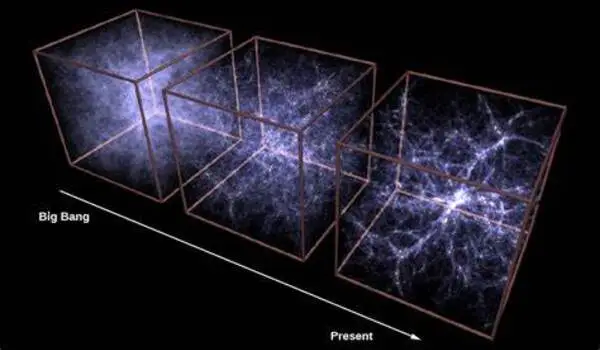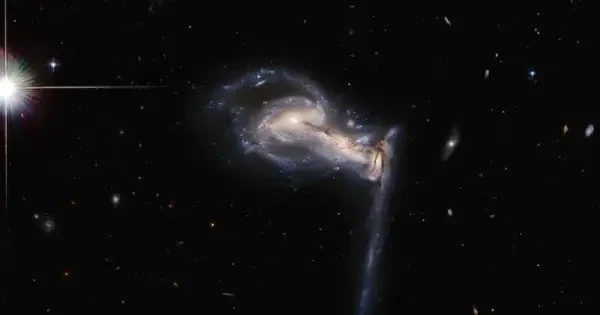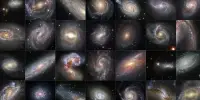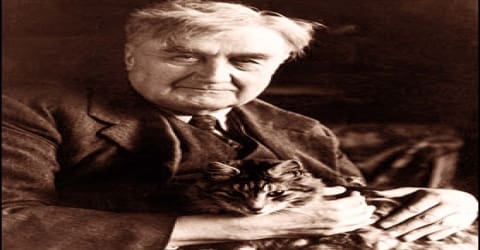Scientists expect enormous cosmic structures to grow at a particular rate as the universe evolves: dense places such as galaxy clusters will grow denser, while the nothingness of space will grow emptier. However, researchers at the University of Michigan revealed that the rate at which these massive structures expand is slower than predicted by Einstein’s Theory of General Relativity.
They also demonstrated that, as dark energy drives the universe’s global expansion, the suppression of cosmic structure growth shown in the researchers’ data is considerably stronger than predicted by the hypothesis. Their findings have been published in Physical Review Letters.
Galaxies are woven like a gigantic cosmic spider web throughout our cosmos. Their distribution is not haphazard. Instead, they tend to congregate. In fact, the entire cosmic web began in the early cosmos as tiny clumps of matter that developed into individual galaxies, and then galactic clusters and filaments.
If gravity acts like an amplifier enhancing matter perturbations to grow into large-scale structure, then dark energy acts like an attenuator damping these perturbations and slowing the growth of structure. By examining how cosmic structure has been clustering and growing, we can try to understand the nature of gravity and dark energy.
Minh Nguyen
“Through gravitational interaction, an initially small clump of mass attracts and accumulates more and more matter from its local region throughout cosmic time. As the region becomes denser and denser, it eventually collapses under its own gravity,” said Minh Nguyen, the study’s principal author and postdoctoral research researcher in the University of Michigan’s Department of Physics.
“As they collaps, the clumps become denser.” That is what we mean by development. It’s similar to a fabric loom, with one-, two-, and three-dimensional collapses representing a sheet, a filament, and a node. The truth is a combination of all three scenarios, with galaxies residing along the filaments and galaxy clusters – collections of thousands of galaxies, the most massive objects in our universe connected by gravity – sitting at the nodes.”
The universe is made up of more than just matter. It is also believed to include a mystery component known as dark energy. On a global scale, dark energy drives the expansion of the cosmos. Dark energy has the opposite effect on massive structures since it accelerates the expansion of the universe.
“If gravity acts like an amplifier enhancing matter perturbations to grow into large-scale structure, then dark energy acts like an attenuator damping these perturbations and slowing the growth of structure,” Nguyen said. “By examining how cosmic structure has been clustering and growing, we can try to understand the nature of gravity and dark energy.”

Nguyen, U-M physics professor Dragan Huterer, and U-M graduate student Yuewei Wen examined the temporal growth of large-scale structure throughout cosmic time using several cosmological probes.
First, the team used what’s called the cosmic microwave background. The cosmic microwave background, or CMB, is composed of photons emitted just after the Big Bang. These photons provide a snapshot of the very early universe. As the photons travel to our telescopes, their path can become distorted, or gravitationally lensed, by large-scale structures along the way. Examining them, the researchers can infer how structure and matter between us and the cosmic microwave background are distributed.
Nguyen and colleagues took advantage of a similar phenomenon with weak gravitational lensing of galaxy shapes. Light from background galaxies is distorted through gravitational interactions with foreground matter and galaxies. The cosmologists then decode these distortions to determine how the intervening matter is distributed.
“Crucially, as the CMB and background galaxies are located at different distances from us and our telescopes, galaxy weak gravitational lensing typically probes matter distributions at a later time compared to what is probed by CMB weak gravitational lensing,” Nguyen said.
To track the growth of structure to an even later time, the researchers further used motions of galaxies in the local universe. As galaxies fall into the gravity wells of the underlying cosmic structures, their motions directly track structure growth.
“The difference in these growth rates that we have potentially discovered becomes more prominent as we approach the present day,” Nguyen said. “These different probes individually and collectively indicate a growth suppression. Either we are missing some systematic errors in each of these probes, or we are missing some new, late-time physics in our standard model.”
The findings could help to resolve the so-called S8 tension in cosmology. S8 is a parameter that describes structural growth. The conflict emerges when scientists employ two distinct ways to calculate S8, and they do not agree. The first approach, which uses photons from the cosmic microwave background, yields a larger S8 value than observations of galaxy-weak gravitational lensing and galaxy clustering.
Neither of these probes now assesses the expansion of the structure. Instead, they examine structures in the past and extrapolate those measurements to the present, adopting the standard model. The cosmic microwave background examines early universe structure, whereas galaxy weak gravitational lensing and clustering probe late universe structure.
The researchers’ findings of a late-time suppression of growth would bring the two S8 values into perfect agreement, according to Nguyen.
“We were surprised with the high statistical significance of the anomalous growth suppression,” he said. “To be honest, I think the universe is trying to tell us something.” It is now up to us cosmologists to interpret these results.
“We’d like to strengthen the statistical evidence for growth suppression.” We’d also like to find out why structures grow slower than expected in the standard model with dark matter and dark energy. This effect could be caused by unique features of dark energy and dark matter, or by some other extension of General Relativity and the standard model that we haven’t yet considered.”
















